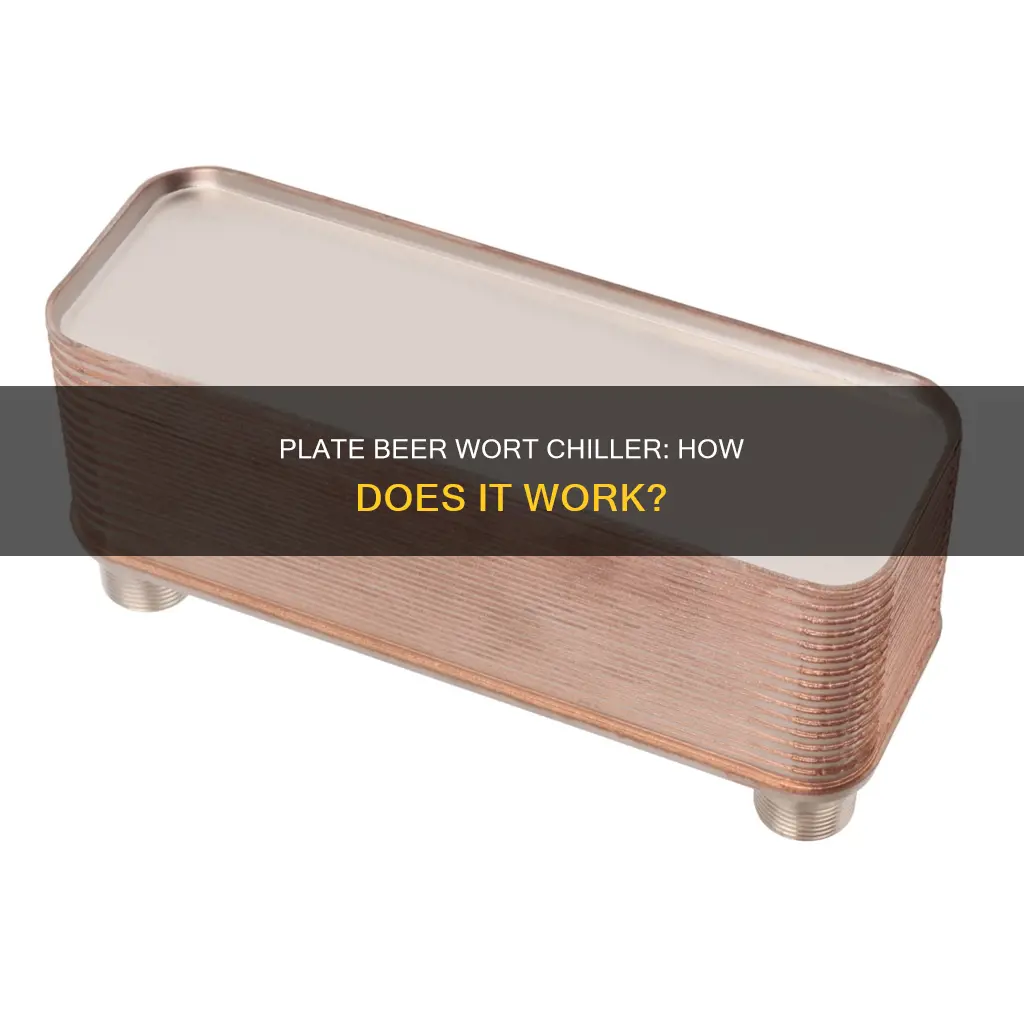
Plate beer wort chillers are a crucial step in the brewing process. They work by passing wort through the inside of the chiller, in the opposite direction of the cool water flow. The wort is drained from the kettle, through the chiller, and into the fermenter. Plate chillers are more expensive but more efficient than immersion chillers. They have a high surface-to-volume ratio, making them effective at rapidly reducing wort to pitching temperatures.
| Characteristics | Values |
|---|---|
| Construction | Many thin layers of stainless steel or copper plates |
| Function | Rapidly reduces wort to pitching temperatures |
| Efficiency | High surface-to-volume ratio makes them efficient |
| Use | Drain the wort from the kettle, through the chiller, and into the fermenter |
| Size | 8.25 inches long, 4 inches high and 3 inches wide |
| Wort Inlet/Outlet | 1/2" MPT |
| Water Inlet/Outlet | 3/4" MGHT |
What You'll Learn

Plate chillers are more efficient than immersion chillers for large batches
However, plate chillers can be more challenging to clean than immersion chillers due to their compact design with many small parts. It is crucial to clean plate chillers thoroughly to prevent infections and off-flavours in the beer. Some brewers choose to backflush their plate chillers with sanitising solutions and hot water to ensure they are clean. Others opt for boiling their plate chillers to sanitise them, although this method may not remove all organic material.
Immersion chillers, on the other hand, are relatively inexpensive and easy to use. They are made of copper, which has very high thermal conductivity, resulting in excellent chilling power. Immersion chillers are simple to clean as they are fully visible and do not have small parts where dirt can accumulate. They are also low-maintenance, requiring only a quick spray-down after use.
While both types of chillers are effective, plate chillers are more efficient for large batches due to their higher surface-to-volume ratio and counterflow design. However, the increased efficiency comes at the cost of more complex cleaning and sanitation procedures.
The Magic of Beer Fob: How It Works
You may want to see also

Plate chillers are made of many thin layers of stainless steel
Stainless steel is chosen as the material for plate chillers because it is way easier to clean than other metals. You don't have to worry about scratching, kinking, or breaking it, and you can leave it in any cleaner for as long as you want without harming the metal.
Plate chillers are very stiff and sturdy, and users have reported that they are "well built", "high quality", and "very durable".
Beer Butt Chicken: Does It Work?
You may want to see also

Plate chillers are prone to clogging
One way to prevent clogging is to use a hop bag or spider to contain the hops and prevent them from entering the chiller. These can be made from stainless steel or mesh and are placed in the boil kettle to catch the hops. Another option is to use a false bottom in the boil kettle, which will catch the hot break and any other solids, preventing them from entering the chiller.
It is also important to clean the plate chiller regularly. Flushing it with hot PBW (phosphoric acid-based warehouse floor cleaner) immediately after use can help remove any remaining solids and sanitise the equipment.
Some brewers also recommend using a pump to agitate the wort and prevent solids from building up. Others suggest draining the boil kettle slowly, as this can help reduce the risk of clogging by minimising the amount of solids that enter the chiller.
Finally, it is important to consider the design of the plate chiller itself. Some chillers have plates that are too close together, which can make them more prone to clogging. Chillers with more plates or a longer design may be less likely to clog.
Beer Mile Basics: Drink, Run, Repeat
You may want to see also

Plate chillers are more expensive than immersion chillers
Immersion chillers, on the other hand, are relatively inexpensive and easy to use. They are also simple to clean, as the entire surface that comes into contact with the wort is visible and can be easily scrubbed. Immersion chillers are a good option for standard batch sizes.
However, plate chillers offer several advantages over immersion chillers. They provide a faster chilling process, reduced cooling time, high efficiency, and portability. Plate chillers are a good option for batches over 10 gallons.
Centrifugal Force: Spinning Beer to Perfection
You may want to see also

Plate chillers are harder to clean than immersion chillers
One user describes their experience with a plate chiller:
> I would back flush it, soak it, starsan, pbw, and still get floaties when I ran boiling water through it before use on my brew days.
Another user echoes this sentiment:
> I abandoned my plate chiller recently. I got tired of it clogging with hop material, especially when doing back-to-back batches. Also, no matter how thoroughly I cleaned it after a brew day, a week later I could run the hose through it and nasty stuff would come out.
In contrast, immersion chillers are relatively easy to clean. One user describes their cleaning process:
> All you need to do is spray it down after use and then drop it in your boiling wort 15 minutes before use and it’ll be clean.
Another user agrees:
> The cleaning required [for a plate chiller] was always a sticking point for me, but I figured that eventually I'd get one, once the prices on the chillers that could be taken apart and cleaned came down.
While plate chillers are more difficult to clean than immersion chillers, some users have found ways to make the cleaning process easier. One user recommends:
> I boil [my plate chiller] for 10 mins the morning or day before I brew. I clean it after every brew by running and soaking in PBW. Even after thorough cleaning and back flushing, hops still come out after boiling the chiller. Never had an infection or plugged chiller. So far imo the plate chiller is far superior to my old immersion chiller... but there is a little bit more maintenance to be done with plate chiller.
Another user shares their cleaning process:
> I use quick disconnects, and fashioned an adaptor to use the garden hose directly into the wort lines, which lets 80psi water backflow and forward flow a few times to knock out the crud.
Understanding Beer Distribution: From Brewery to Glass
You may want to see also
Frequently asked questions
A plate beer wort chiller is a device used to cool down wort—the hot, unfermented liquid made during the brewing process—after the boil. Plate chillers are more efficient than immersion chillers and are capable of chilling larger batches of wort very quickly.
Plate chillers work by passing the wort through the inside of the chiller, in the opposite direction of the cool water flow. The cool water source passes through copper or steel, absorbing heat from the wort as it flows through the chiller.
Chilling wort quickly helps minimize the possibility of contamination by spoilage organisms that thrive in warm temperatures. Plate chillers are also more economical than immersion chillers as they use less water.
Some popular plate beer wort chillers include the Blichmann Therminator, the Fermentap Wort Chiller, and the Northern Brewer Plate Chiller.
One potential issue with plate chillers is the risk of clogging due to ingredients or heavier particles in the trub. Plate chillers also tend to be more expensive and require diligent cleaning and sanitation.







